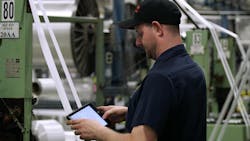Operators Connected by Technology Don’t Quit
Sometimes the truth hurts worse when everyone knows it.
That’s precisely what "connected worker" technologies do. They disseminate at the organizational level data about your plant’s issues with quality, productivity and efficiency.
Employing the technology can therefore look very unattractive to some manufacturers, but what if that technology broadcasts success instead of failure and your operators can point at how their feedback, reported for all the company to see, led to those successes?
Connected worker technologies run the gamut from simple options like smartphones, tablets and boards mounted on walls or hanging from ceilings to advanced devices like augmented and mixed reality headsets. The pitch for all the technologies, low- and high-tech, remains the same: allowing operators on the floor to widely share and distribute information like machine health, cycle times and shift results.
This also means digitizing plant data rather than clinging to analog methods like pen-and-paper documents, mind-numbingly transferring data into Excel spreadsheets and databases, followed closely by the painstaking task of running queries and cobbling together reports that often contain outdated information and too late to serve any practical use.
Eric Whitley serves as the director of industrial transformation at software company L2L, formerly Leading2Lean, a company spun out from automobile safety device manufacturer Autoliv and born from its lean expertise. Whitley, who previously worked at Autoliv and McDonnell Douglas, also consults on maintenance and lean, teaches classes, hosts the Manufacturing Stream podcast and has “been in every type of factory you could possibly conjure up in your head.”
L2L recently released a report titled “What’s Holding Manufacturers Back in 2024?” that discusses the impact of the manufacturing labor shortage, the state of workplace communication and manufacturers’ progress digitizing factory floors. IndustryWeek sat down with Whitley to discuss the report’s conclusions. This conversation has been edited for length and clarity.
IndustryWeek: 46% of respondents said there have been significant resignations at their organization in the past year. Can we define “significant?”
Eric Whitley: I don’t know that we actually have a data point around what that means by "significant" resignation. But what we see is there are a lot of folks who come into manufacturing and then move on.
Over the years that I’ve done consulting and teaching and have been in all these different industries, I see where people get caught up into the thought process of “We make donuts, so we’re different than the guy who makes pastries,” or “We’re totally different than the automotive industry, or the people who make packaging.” The fact of the matter is, if you look at a manufacturing plant, there are people, there are machines. Those machines have basic principles to them. So what we’re seeing is that people can actually move from manufacturing plant to manufacturing plant, regardless of what sector they’re in, and pick right up.
IndustryWeek: 75% of respondents said they noticed a lack of skilled workers in the market in the past year. How do we define “skilled?”
Eric Whitley: What happens when you have a fault reset? What happens when you have a jam? How do you monitor it? How do you turn it on? I think those are the skills we’re talking about. Just being able to go in and run a production line. Basic skills. And that’s why, going back to our last question, that’s why it’s so easy for somebody to leave one production line making donuts and go down the street and go to the next production line that’s making airbags, because they have this general mechanical ability. Ten years ago, we were talking to people that had 30 years in a manufacturing plant, and now the worker in the manufacturing plant, they may only have been in there three years. That is just a general lack of experience working in manufacturing.
IndustryWeek: 40% of respondents said they were not satisfied with their current jobs. 31% said they wanted to leave their current jobs. According to your data, why?
Eric Whitley: We know that pay is always the No. 1 thing. The other thing is communication. People are less tolerant when they know they can go down the road and get a job just the same as what they’re doing now and maybe get a better boss, and maybe feel more involved, like they’re being heard in the process.
That’s where we come in from a technological standpoint. During a normal day, when a supervisor has four or five production lines that have 5-to-10 people each, every one of those people are going to walk up to the supervisor and voice a concern. If there’s not a system or a process for that supervisor to be able to catalog those things, that leader is going to take the top two or three that they feel [are most important] and the other 17 get dropped. Then the people who said those things are going to feel like they’re not being listened to.
What we do really well in manufacturing is to solve problems. Why don’t we just apply that? Let’s not unload that to the HR department, because we’re really good at solving problems on the shop floor. Let’s just use that same methodology, whether it’s Six Sigma, whether it’s lean methodology, 5S, whatever it is that we need to do in order to solve that problem in our factory, in order to move the factory forward. If the issues are visible, and we have accountability to the issues, and those issues are visible and anybody at any point in time can see what’s happening....
IndustryWeek: We’re talking about single source of truth. Drawing conclusions from digitized data versus analog reporting.
Eric Whitley: We use that term a lot, that L2L literally is the single source of truth on the shop floor, because everybody can see it. Quality, downtime, maintenance, production, safety, all of that stuff is right there in front of your face.
IndustryWeek: Isn’t there a danger of weaponizing connected workforce platforms? A positive use is to find a shift that over produces and then distill their skills into new training programs. What’s this shift doing that nobody else is? Isn’t there a danger from the other side, to penalize shifts that aren’t performing well?
Eric Whitley: We get that concern all the time. We don’t want this to be Big Brother. But what we find is that when we involve the operators in the process of being able to tell us why they didn’t [meet productivity expectations] … and they understand that they can tell [management] every reason why they didn’t get to the number, it becomes quite empowering to the worker on the shop floor.
If there is any type of a problem on the shop floor, and we could go to the extremes about communication and how failure [to communicate] has been catastrophic. I would say every lack of communication on a manufacturing floor, if it’s about a problem, it can be catastrophic.
IndustryWeek: "Catastrophic" is a very strong word.
Eric Whitley: My lean roots are in automotive, in the airbag industry. And through the 2000s it was absolutely catastrophic what happened in the airbag industry, because of quality issues. People within that organization knew there was a potential issue, and they just did not communicate it properly, or did not mitigate the issue early on in order to avoid that catastrophe.
IndustryWeek: Maybe it wasn’t the communication not getting where it needed to be, but intentionally not being heard. Even if you have data from a connected worker platform, that data can still be suppressed. It doesn’t have to be released, right?
Eric Whitley: People on the shop floor become your greatest source of real time data, and that information goes inside of the connected worker platform so people can see it. So when you pull up a Pareto chart [to look at your] number one quality issue, it’s there. Everybody can see it and everybody has access to that data. The ability to shove that off to the side becomes much harder. It’s actually a legal issue if you’re taking all of this quality data and throwing it away, or hiding it from somebody, and then later on down the road you’re having to replace 50 million airbags in cars. The visibility really is very powerful when it comes to mitigating those issues.
IndustryWeek: In the section of the report regarding digitizing the factory floor, the question on why manufacturers don’t invest caught my attention. 36% of respondents said they lack the personnel. 22% said budgetary constraints and integration issues and 21% said executive buy-in.
Flipping those numbers, two-thirds of the respondents do have the personnel, 80% aren’t facing budgetary constraints, and 80% do have executive buy-in. So isn’t that a rosy outlook for digitization?
Eric Whitley: It is, but then the question becomes why aren’t you doing it? You’re building what your MES tells you to build, and you’re producing what your SCADA system reports you’re producing, but what’s going on in the middle? Downtime. Quality issues. Safety issues. Those are the missing pieces of the data in the middle … that help the person on the shop floor.
That is the issue in the connected worker space right now. Trying to show people that there’s a new thought process, a middle piece that really fills in the missing gap of what’s happening in your entire organization.
About the Author
Dennis Scimeca
Dennis Scimeca is a veteran technology journalist with particular experience in vision system technology, machine learning/artificial intelligence, and augmented/mixed/virtual reality (XR), with bylines in consumer, developer, and B2B outlets.
At IndustryWeek, he covers the competitive advantages gained by manufacturers that deploy proven technologies. If you would like to share your story with IndustryWeek, please contact Dennis at [email protected].



